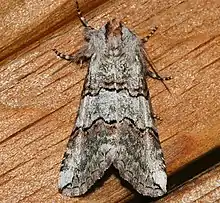Ceranemota fasciata
Ceranemota fasciata is a moth in the family Drepanidae. It was described by William Barnes and James Halliday McDunnough in 1910.[1] It is found in North America, where it has been recorded from British Columbia to northern California. It is also present in coastal southern Alaska.[2] The habitat consists of coastal rainforests, mixed hardwood forests and montane riparian areas.
| Ceranemota fasciata | |
|---|---|
 | |
| Scientific classification | |
| Kingdom: | |
| Phylum: | |
| Class: | |
| Order: | |
| Family: | |
| Genus: | |
| Species: | C. fasciata |
| Binomial name | |
| Ceranemota fasciata (Barnes & McDunnough, 1910) | |
| Synonyms | |
| |
The length of the forewings is 16–20 mm. The forewings are mottled medium grey with a slight green sheen. The hindwings are light grey with weakly darker grey markings and a faint pink tinge along the fringe. Adults are on wing from July to November in one generation per year.
The larvae feed on Amelanchier alnifolia and Prunus species, including Prunus ilicifolia and Prunus virginiana. The larvae have a mottled white and black pattern.[3]
References
- Beccaloni, G.; Scoble, M.; Kitching, I.; Simonsen, T.; Robinson, G.; Pitkin, B.; Hine, A.; Lyal, C., eds. (2003). "Ceranemota fasciata". The Global Lepidoptera Names Index. Natural History Museum. Retrieved May 17, 2018.
- "850011.00 – 6243 – Ceranemota fasciata – (Barnes & McDunnough, 1910)". North American Moth Photographers Group. Mississippi State University. Retrieved June 7, 2019.
- Pacific Northwest Moths